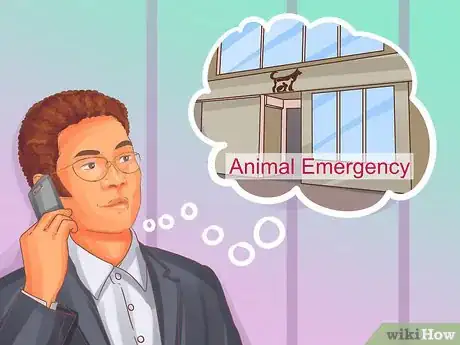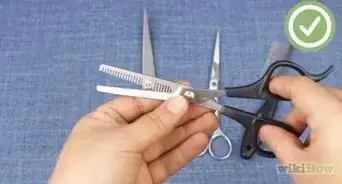This article was co-authored by Deanne Pawlisch, CVT, MA. Deanne Pawlisch is a Certified Veterinary Technician, who does corporate training for veterinary practices and has taught at the NAVTA-approved Veterinary Assistant Program at the Harper College in Illinois and in 2011 was elected to the board of the Veterinary Emergency and Critical Care Foundation. Deanne has been a Board Member of the Veterinary Emergency and Critical Care Foundation in San Antonio, Texas since 2011. She holds a BS in Anthropology from Loyola University and an MA in Anthropology from Northern Illinois University.
There are 10 references cited in this article, which can be found at the bottom of the page.
This article has been viewed 9,807 times.
Choosing a veterinarian for your cat is much like choosing a doctor for yourself. The veterinarian needs to be competent enough to provide solid care for your animal. Plus, both you and your cat need to be at least somewhat comfortable with the vet. It's not just about the vet's personality and style, however. You also need to be comfortable with the clinic as a whole. Start by getting recommendations from friends and family, so you can begin your search with a list. Then you can visit the clinic, first by yourself and then with the cat, to help you decide.
Steps
Narrowing Down Your Choices
-
1Ask for recommendations. A good place to start when looking for a vet is to ask people you know for recommendations. Stick to people who think of pet care in the same way as you do. For instance, if you prefer home remedies whenever possible, ask someone who has a similar viewpoint.[1]
- If your cat is a purebred, you can ask for recommendations at a local club specializing in that breed.
- Ask your current veterinarian for a recommendation if you're moving to a different city. They may be able to recommend someone.[2]
-
2Search on your own. You can also start by looking online or in the phone book. If you look online, you may be able to find reviews of the vet. Even if you can't find reviews, the vet may have a website where you can see photos and read about the vet's philosophy, services, and pricing, which will give you an idea of what to expect.[3]
- Use databases like http://catfriendly.com/find-a-veterinarian/ to find veterinarians in your area.
- Think about location. If you don't want to drive a long way, look at vets close to you first.
-
3Look for vets that are professionally accredited. Try to find a vet that is a member of 1 or more professional organizations in order to be assured that your cat will get a high standard of care. In the US, look for vets that are accredited members of the AAHA (American Animal Hospital Association). You can search for accredited vets in your area using the locator tool at aaha.org.
- You may wish to find a vet who is a member of the American Association of Feline Practitioners in addition to having AAHA accreditation. The AAFP website at catvets.com offers a variety of resources for cat owners, including a directory of member vets and Cat Friendly Practices.
-
4Decide what you need from a veterinarian. Maybe you want to be at a small clinic where you know everyone. Maybe you want to be at a hospital where you can get anything done, even surgery. Maybe your cat has special needs and requires a specialist. Weigh all of these needs when narrowing your choices.[4]
- If you need to board your cat from time to time, look at veterinarians with boarding facilities.
-
5Check for emergency services. If you specifically need a vet with emergency services, focus on that when you are looking by using it as a search term. For emergency services, you'll likely need to find a bigger clinic or hospital. However, keep in mind that you can have veterinarian at a smaller clinic and still take your cat to a separate place with emergency services when you need to.
- You can also ask about emergency services when you call. If the veterinarian doesn't offer emergency services, ask if they send their patients to a specific place for emergency care.
-
6Consider price. Price is also a factor, of course. Smaller clinics may be cheaper than larger ones. All-inclusive hospitals tend to be more expensive. When you go to the clinic or call them, ask for a list of basic prices so you can compare.[5]
- Also, check payment options. See if they take credit cards, for instance, and if they offer payment plans for large bills.[6]
-
7Choose a vet before your cat needs it. You may put off finding a veterinarian, thinking you have time. However, if your cat has a health problem, you want to have someone you can call who knows your cat's history. Pick a veterinarian out who will be your cat's primary veterinarian, just like you have a primary doctor.[7]
Meeting the Veterinarian
-
1Call in advance to set up a meeting. After you've narrowed your choices to 1 or 2 veterinarians, it's time to meet with the vet or at least talk to them on the phone. Call ahead to schedule an appointment. Make it clear that you want to meet the vet without your pet so you can ask questions and decide if that clinic is the right place for you and your cat. Most veterinarians are more than willing to meet prospective clients.[8]
- Many vets charge a fee for this type of visit. Ask in advance about each vet’s policies on prospective client interviews.
-
2Have questions prepared. Before you go in, write out the questions you want to ask the veterinarian and their staff. Keep in mind that the vet may have scheduled a short appointment for you, but you should be able to ask the staff questions even if the vet needs to move on to their next appointment.[9] You could ask questions such as:
- What are your office hours?
- What are your fees like? Do you offer payment plans?
- What types of services do you offer? Do you have boarding services?
- Do you take after-hours patients?
- Do you have sedation services? How do you handle cats who aren't comfortable with the vet? (If your cat isn't comfortable going to the vet and it gets vicious while there, it may need to be sedated for visits.)
- Are you members of professional organizations?
-
3See if you're comfortable with the staff and vet. When you're visiting, make sure you like the people who work at the clinic. Of course, you don't need to be best friends with the veterinarian. However, you should feel like you can speak up and ask questions, and you should feel comfortable with the vet, their staff, and the overall environment of the clinic or hospital.[10]
-
4Look around the facility. While you're there, make sure to check out the facility. It should look clean and orderly, and it shouldn't smell awful. Check out the other customers and pets there. Do the pets seem happy and healthy? Of course, some pets will be there because they're sick, but don't be afraid to talk to other customers about their experiences there.[11]
- If you want to see the non-public areas of the hospital or clinic, let the office staff know ahead of time. They will need to schedule your visit so that it does not interrupt any procedures or disturb any sick pets.
Taking Your Cat for a Visit
-
1Make the carrier comfortable. The key to getting your cat in a carrier is to make it a happy place ahead of time. Put it out where the cat can see it, and leave the door open. Add toys to it. Place a blanket inside or even a shirt that smells like you. Your cat will likely get curious and explore the carrier on its own.
- Put the carrier out weeks ahead of time to get your cat used to the idea.
- If the cat doesn't seem interested at first, try putting some treats inside the carrier to entice the cat in.
-
2Use a pheromone spray. Sometimes, a synthetic pheromone spray can help a nervous kitty. Spray it inside the carrier 30 minutes before you need the cat to be in the carrier, focusing on the soft bedding. The pheromone spray will keep the cat calmer while traveling.
- This spray mimics the smell that cats use to mark areas with their faces and paws. It makes them feel safer because it indicates the territory is already marked.[12]
-
3Try practice visits. Before you take your cat for an official visit, bring your cat to the veterinarian’s office for a practice run. You could even do it once or twice a week so your cat gets used to the idea. At the vet's, give the cat treats so it associates the vet with good things.[13]
- Taking your cat to the vet's office will get it used to the environment, too, including the smells and sounds. You can also see how your cat will react to other animals nearby.
-
4Handle your cat as a vet would. When your cat goes to the vet, the vet will want to hold it down and examine its torso, paws, teeth, and ears. If your cat tends to get agitated or aggressive during an exam, the vet may need to scruff its neck. Try these techniques out at home by handling your cat's paws, for instance, or gently grabbing the scruff of its neck sometimes (the skin at the back of the neck just behind the head). Start out with short periods and work up to a bit longer.[14]
-
5Schedule a well-cat visit. A well-cat visit is just a checkup, much like you'd go to the doctor for a checkup. It also establishes your cat as a patient. Make an appointment for your cat to meet the vet and have its health checked out. Your vet hospital or clinic may schedule a longer appointment the first time, especially if your cat has never been to any vet. That will give the cat and the vet a chance to get to know one another.[15]
- Watch how the vet examines your cat. The vet should be talk to the cat in a calming voice and try to soothe it during the exam. You should feel like the vet is giving their full attention to the cat.
- Look for a veterinary hospital or clinic that is certified low-stress handling.
References
- ↑ http://www.humanesociety.org/animals/resources/tips/choosing_a_veterinarian.html
- ↑ https://www.avma.org/public/YourVet/Pages/finding-a-veterinarian.aspx
- ↑ http://www.humanesociety.org/animals/resources/tips/choosing_a_veterinarian.html
- ↑ http://www.hillspet.com/en/us/cat-care/routine-care/choosing-the-right-vet-for-your-cat
- ↑ http://www.hillspet.com/en/us/cat-care/routine-care/choosing-the-right-vet-for-your-cat
- ↑ https://www.avma.org/public/YourVet/Pages/finding-a-veterinarian.aspx
- ↑ https://www.avma.org/public/YourVet/Pages/finding-a-veterinarian.aspx
- ↑ https://www.avma.org/public/YourVet/Pages/finding-a-veterinarian.aspx
- ↑ https://www.avma.org/public/YourVet/Pages/finding-a-veterinarian.aspx
- ↑ http://www.hillspet.com/en/us/cat-care/routine-care/choosing-the-right-vet-for-your-cat
- ↑ https://www.avma.org/public/YourVet/Pages/finding-a-veterinarian.aspx
- ↑ https://indoorpet.osu.edu/cats/problemsolving/spraying-and-marking
- ↑ https://www.petfinder.com/cats/cat-health/tips-for-taking-cat-to-vet/
- ↑ https://www.petfinder.com/cats/cat-health/tips-for-taking-cat-to-vet/
- ↑ http://www.hartz.com/selecting-a-vet-for-your-cat/
About this article
To find a vet for your cat, start by asking friends and family who have cats if they have any recommendations. You can also search online for cat vets in your area and read reviews to get an idea of the vet’s philosophy, services, and pricing. When you’re researching the vet, look for an accreditation from a professional organization like the American Animal Hospital Association so you can be sure your cat will get a high standard of care. Once you’ve found a vet you like, don’t be afraid to go for a visit to talk to the staff and look around the facilities. For more tips from our Veterinary co-author, including how to prepare your cat for its first vet visit, read on!

































